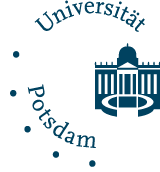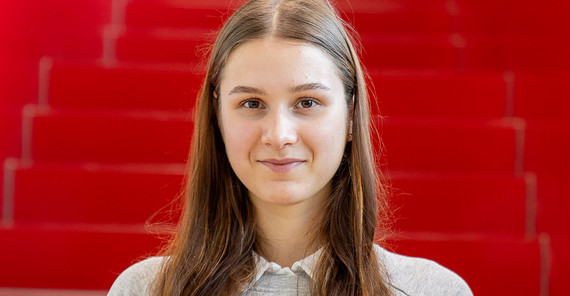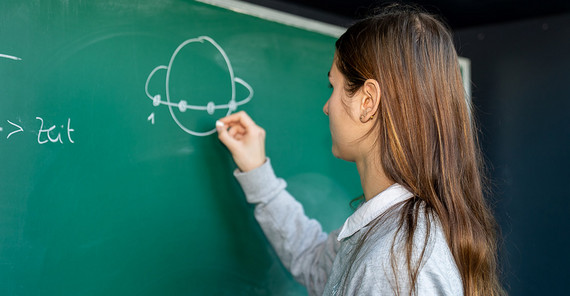Since the winter semester 2024/25, Weiß has been studying physics at the University of Potsdam. “I am really happy with only doing physics and math. That’s what I enjoyed most at school.” She recently moved from her hometown, Vogelsdorf, to Potsdam, into her first own apartment.
Research at the school observatory
In the 9th grade, the curious student first began studying already known planets outside our solar system – the so-called exoplanets. It was then that she learned about the “transit method”: During its orbit, a celestial body covers the star around which it is orbiting for some time. As a result, its brightness decreases. A telescope takes hundreds of images of this so-called transit. Anna Maria Weiß used a computer to compare the brightness of the stars and was thus able to calculate the relative dimming in the starlight. This also enabled her to determine the radius of the exoplanet.
The Einstein Gymnasium in Neuenhagen, the high school she attended, has its own observatory. There, she first observed planetary transits. “The school has a STEM focus, and the principal is an astrophysicist,” she says. Because she enjoyed researching so much, she kept at it in the 10th and 11th grades. The principal recommended her for an internship at the Leibniz Institute for Astrophysics (AIP) in Potsdam. She was 16 at the time. “I learned really amazing things there." In the 12th grade, she wrote her research paper on exoplanets with astrophysicist Eliana Amazo-Gomez from the AIP. With Amazo-Gomez’s expertise, she succeeded in discovering the exoplanet TOI1147 – and winning the national youth science competition “Jugend forscht” in the field of geosciences and space sciences[SV1] . She has stayed in contact with the research institution ever since and has even been an official guest of the “Stellar Physics and Exoplanets” working group since 2023. “I don’t cost anything and just do it out of interest.”
Side job at the research institute
She is also a research assistant in the “Astrophotonics” research group at AIP, which develops instruments for very sensitive telescopes. “When I was at school, I worked at a gas station to earn money. Now I can work in my field. And at the AIP, I’m already learning how to write papers.” Weiß is glad that she had the opportunity to gain scientific experience and to conduct applied research before her studies. “You would usually only have that opportunity after a bachelor’s degree. That makes me very happy.”
Her parents also support her and used to read her school research papers. Neither of them has a high school diploma, but they listen with rapt attention when she talks about the latest research findings. When Weiß talks passionately about radial velocities, the transit method, and orbits, not everyone is able to follow her. But the 18-year-old still finds people to talk to everywhere. “Fortunately, people are very curious when it comes to stars and planets.”
One of 7,000 unknown planets
But how did the student find “her” celestial body in the first place? The Transiting Exoplanet Survey Satellite (TESS), a NASA space telescope, continuously scans the sky and discovers new exoplanets. All presumed planets from this mission are summarized in a table – currently around 7,000 objects. Weiß preselected planets based on parameters such as size and star brightness, ensuring that she could even see the planets from Earth. She then searched through the light curves of hundreds of celestial bodies that TESS had observed and ended up finding two that she wanted to examine in more detail. Then it was time for “follow-up observations,” because dimming does not necessarily have to come from planets; it could also be caused by spots on the surface of the star or a second star orbiting around the other. In the case of the second celestial body, a young star, the calculation of the radial velocity failed.
TOI1147 – TOI stands for “TESS Object of Interest” – was different. The student chose a planet that is visible all night and all year round. The planet has 1.3 Jupiter masses and 2.3 Jupiter radii. “This shows that it must have a fairly low density, which is special,” Weiß explains. It takes 10.9 days to orbit the large star, so the distance between the two is comparatively small. This makes the exoplanet a so-called hot Jupiter. However, this distance is not constant because the planet‘s orbit is highly elliptical. When it gets very close to the star, it accelerates. “These are extreme conditions,” Weiß says.
She observes the planet using the STELLA telescope on Tenerife, a joint project of the AIP and the Instituto de Astrofísica de Canarias in Spain – remotely, of course. She does not fly to the Canary Islands all the time. „Although that would also be nice,” says Weiß and laughs. “We are currently in a phase in astrophysics that is super interesting because the telescopes are getting bigger and bigger, and we are getting better data,” she says enthusiastically. The robotics for the telescope were developed by colleagues at the AIP.
Networking for data from space
In May 2025, the student will represent Germany at the Regeneron International Science and Engineering Fair (ISEF) in the USA, where young people from all over the world will compete against each other with their research projects. Here, she will present the same work as in “Jugend forscht”, but with the addition of new data. “Because I have been observing the planet for over a year now, I was able to find out that there is a 0.1 solar mass star orbiting around it and the large star,” she reports enthusiastically. This star has a very long orbital period, around 700 days. The observations will continue until her bachelor‘s thesis. “By then, I will have observed it for two to three periods and will be able to integrate the results properly.”
Anna Maria Weiß has been interested in space since childhood. On her iPad, she preferred to watch documentaries with astrophysicist Harald Lesch. „Last year, I was even able to meet him in person at a competition held by the Ludwig Maximilian University of Munich.” And she visited the Wendelstein Observatory of the Institute for Astronomy and Astrophysics of the University of Munich, located on the summit of Wendelstein in the Bavarian Alps. She looked through the telescope almost all night, sleeping only two hours. “They are now also observing my exoplanet!” Weiß says enthusiastically. Whichever observatory she visits, she always asks the staff to observe her planet. “Yesterday I attended a cool astronomy lecture. I am going to work with the lecturer after my exams to find out more about the second star using machine learning. Weiß knows how to network – all to quench her immense thirst for knowledge about the universe, which remains largely unknown to us.
Dream job: scientist
It is already clear in her first semester what she will write her bachelor‘s thesis about: TOI1147. The fact that her planet is a suitable research topic had already been confirmed by Potsdam astrophysicist Prof. Dr. Philipp Richter when he gave a lecture at her school and spoke with her about “her” celestial body. After that, Weiß wants to pursue a master’s degree in astrophysics, also in Potsdam. For her, it is the ideal place to study. After all, the university closely collaborates with the AIP.
After graduating, Weiß would like to become a scientist – provided it is compatible with having a family. The 18-year-old already knows that children and fixed-term contracts do not always go together. But she already has an alternative in mind: “I could also become a physics teacher. In the 11th grade, I explained the transit method to younger students. I had a lot of fun doing that.”
Comets are named after their discoverers. It's different with planets, which is why TOI1147 will probably never bear her name. But Weiß finds the catalogue names of exoplanets clearer anyway.
This text (in german language) was published in the university magazine Portal - Eins 2025 „Kinder“.


